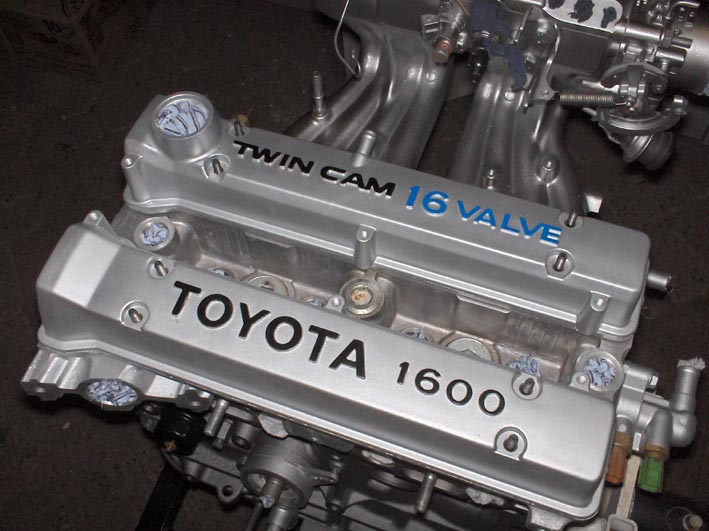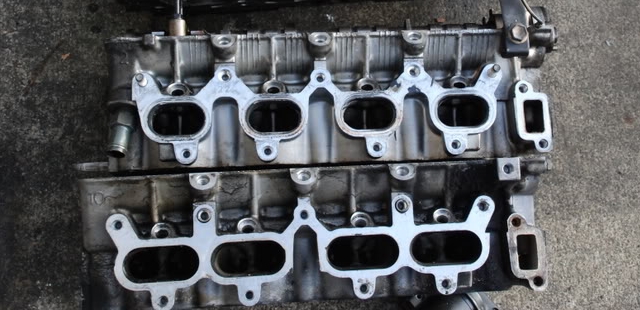Bluetop
Bluetop is actually a term thought of by 4A-GE enthousiasts.
They gave that name to the first generation 4A-GE engines, but it isn't completely correct.
The first generations of the 4A-GE engine (build from '84 to about '89) had the embossed lettering '16 valve' on the valve covers painted in blue.
Some use the term bluetop to distinguish the first two generations (the bluetops) of the 4A-GE from the 3rd generation (the so called redtop). But by doing this, it has already caused quite some confusion because valve covers can be swapped between engines end Toyota themselves had switched to red lettering even before the 'redtop' engine was introduced.

My own 4A-GE Bigport being build with the original blue lettering restored!
Because all of this I prefer the terms 'Bigport' and 'Smallport' to tell them apart.
You can't really go wrong with these terms as it's part of the cylinder head design and the biggest difference between the 2 and 3 generations. And you can easily tell by looking at the intake ports of intake manifold.

The difference in the intake ports of the smallport (above) en bigport (below).
You could also look for the presence of the T-VIS system. That system was needed on the bigport engines to keep the velocity of the air high enough. The smallport didn't need this system as it had a higher air velocity because of the smaller intake ports.
So rule of thumb: T-VIS system present it is a bigport engine. No T-VIS system present and it is a smallport engine. A little side note might be in order here. Some tuners remove the T-VIS system because they see it as a restriction when tuning the engine.
Below you can find the specifications for the
Bigport 4A-GE engines.
1st generation 4A-GE engine
After the 4A-GE engine was developed in collaboration with Yamaha (who
designed the cylinder head) as the successor to Toyota's sporty 2T-G
engine, the engine was first introduced in the famous RWD Corolla AE86.
The engine was received very well and the 4A-GE went on to power the
first generation of the MR2 (AW11), the first Celica's and FWD Corolla's
(E80 series).
Because of different grades of petrol and environmental legislation in
different markets around the world, the exact specifications for the
very same engines can vary.
So the specifications listed below will be those of my European home
market.
|
Engine code: |
4A-GE |
|
Fuel: |
Petrol |
|
Power output: |
+/- 120 hp @ 7000 rpm. |
|
Torque: |
141 Nm @ 6000 rpm. |
|
Number of cylinders: |
4 |
|
Cylinder capacity: |
1587cc |
|
Bore x stroke: |
81,0 x 77,0 mm. |
|
Compression ratio: |
9,4:1 |
|
Number of valves: |
16 |
|
Camshaft layout: |
DOHC |
|
Camshaft drive: |
Belt driven |
|
Camshaft duration: |
240º intake-and-exhaust |
|
Valve lift: |
7,56 mm. intake-and-exhaust |
|
Valve angle |
-45º |
|
Diameter intake valves: |
29,5 mm. |
|
Diameter exhaust valves: |
25,5 mm. |
|
Combustion chamber flow : |
Cross-flow |
|
Cylinder head material: |
Aluminum alloy |
|
Cylinder block material: |
Cast iron |
|
Cylinder block type: |
3-rib |
|
Piston pin diameter: |
18 mm. |
|
Big-end diameter: |
40 mm. |
|
Throttle plate diameter : |
55 mm. |
|
Fuel system: |
EFI (L-jettronic) |
|
Injector capacity: |
182 cc/min. (1 Ohm, topfeed) |
|
Fuel pump pressure: |
75 psi. |
|
Fuel rail pressure: |
35 tot 38 psi. |
|
EFI sensor: |
AFM (Air Flow Meter) |
|
Ignition: |
Electronic (ESA/TCCS) |
|
Sparkplugs type: |
BCPR5EP11 |
|
Engine dry weight: |
Approxametly 135 kg. |
|
Miscellaneous: |
Big-port cylinder head |
2nd Generation
4A-GE
Toyota has made some changes to the 4A-GE engine somewhere in 1986. Part
of the reason for these changes were to beef up the engine a little for
future modifications and even better reliability.
New cylinder blocks were cast with additional strengthening, which was
achieved by adding 4 extra ribs, bringing the grand total to 7 ribs in
the cylinder block.
The connecting rods were also beefed up, the piston pins were now 20mm
and the big ends were enlarged to 42mm to help cope with higher power
outputs.
|
Engine code: |
4A-GE |
|
Fuel: |
Petrol |
|
Power output: |
+/- 120 hp @ 7000 rpm. |
|
Torque: |
141 Nm @ 6000 rpm. |
|
Number of cylinders: |
4 |
|
Cylinder capacity: |
1587cc |
|
Bore x stroke: |
81,0 x 77,0 mm. |
|
Compression ratio: |
9,4:1 |
|
Number of valves: |
16 |
|
Camshaft layout: |
DOHC |
|
Camshaft drive: |
Belt driven |
|
Camshaft duration: |
240º intake-and-exhaust |
|
Valve lift: |
7,56 mm. intake-and-exhaust |
|
Valve angle: |
-45º |
|
Diameter intake valves: |
29,5 mm. |
|
Diameter exhaust valves: |
25,5 mm. |
|
Combustion chamber flow: |
Cross-flow |
|
Material cylinder head: |
Aluminum alloy |
|
Material cylinder block: |
Cast iron |
|
Type cylinder block: |
7-rib |
|
Diameter piston pins: |
20 mm. |
|
Diameter big-ends: |
42 mm. |
|
Throttle plate diameter: |
55 mm. |
|
Fuel system: |
EFI (D-jettronic) |
|
Injector capacity: |
182 cc/min. (2 Ohm, topfeed) |
|
Fuel pump pressure: |
75 psi. |
|
Fuel rail pressure: |
35 tot 38 psi. |
|
EFI sensor: |
AFM (Air Flow Meter) / MAP (Manifold Absolute Pressure) |
|
Ignition: |
Electronic (ESA/TCCS) |
|
Sparkplugs type: |
BCPR5EP11 |
|
Engine dry weight: |
Approxametly 135 kg. |
|
Miscellaneous: |
Big-port cylinder head |